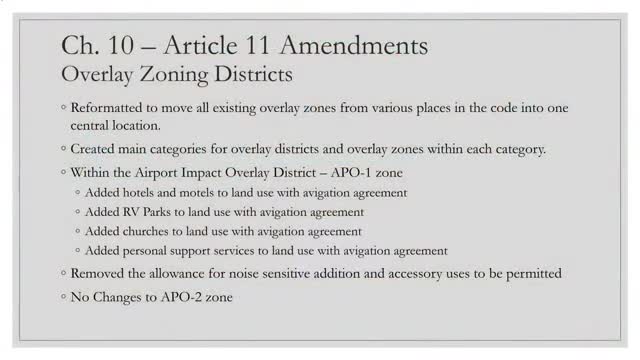Caldwell City Council updates zoning regulations with multiple new overlay districts
February 27, 2025 | Caldwell, Canyon County, Idaho
This article was created by AI summarizing key points discussed. AI makes mistakes, so for full details and context, please refer to the video of the full meeting. Please report any errors so we can fix them. Report an error »

In a recent Planning and Zoning Commission workshop held in Caldwell, Idaho, significant updates to the city’s zoning regulations were discussed, focusing on the introduction of new overlay districts and the reorganization of existing zoning codes. These changes aim to enhance community planning and address specific land use concerns.
One of the key highlights from the meeting was the creation of several new overlay districts, including the Historic Overlay District, which now incorporates the North Caldwell Historic District recognized on the National Register of Historic Places. This addition is seen as a vital step in preserving the historical significance of the area, which consists of just six lots but holds considerable importance for the community.
The commission also discussed the establishment of an Entertainment Overlay District, designed to support the recently adopted master plan for an event center. This move is expected to facilitate future developments that align with the city’s vision for entertainment and community gatherings.
Another significant change involves the introduction of pathways along the Boise River and Indian Creek corridors. These pathways are intended to enhance accessibility and promote outdoor activities, reflecting the city’s commitment to improving public spaces. The commission acknowledged that these requirements had been overlooked in previous codes and emphasized the importance of integrating such features into future developments.
Additionally, the meeting addressed the need for stricter regulations on land uses within the downtown and River District areas. The commission aims to limit heavy industrial uses in these zones to foster a more community-friendly environment. This includes prohibiting certain industrial developments while allowing existing businesses to make improvements that enhance their aesthetic appeal.
The discussions also touched on the need for a comprehensive Parks and Pathways Master Plan, which will identify existing gaps in the pathway network and propose future connections. This plan is expected to take about 18 months to complete and will likely lead to further enhancements in the city’s zoning regulations.
Overall, the workshop underscored Caldwell’s proactive approach to urban planning, focusing on preserving historical areas, enhancing public spaces, and ensuring that future developments align with community needs and values. As these changes move forward, residents can anticipate a more cohesive and thoughtfully designed urban landscape that prioritizes both heritage and accessibility.
One of the key highlights from the meeting was the creation of several new overlay districts, including the Historic Overlay District, which now incorporates the North Caldwell Historic District recognized on the National Register of Historic Places. This addition is seen as a vital step in preserving the historical significance of the area, which consists of just six lots but holds considerable importance for the community.
The commission also discussed the establishment of an Entertainment Overlay District, designed to support the recently adopted master plan for an event center. This move is expected to facilitate future developments that align with the city’s vision for entertainment and community gatherings.
Another significant change involves the introduction of pathways along the Boise River and Indian Creek corridors. These pathways are intended to enhance accessibility and promote outdoor activities, reflecting the city’s commitment to improving public spaces. The commission acknowledged that these requirements had been overlooked in previous codes and emphasized the importance of integrating such features into future developments.
Additionally, the meeting addressed the need for stricter regulations on land uses within the downtown and River District areas. The commission aims to limit heavy industrial uses in these zones to foster a more community-friendly environment. This includes prohibiting certain industrial developments while allowing existing businesses to make improvements that enhance their aesthetic appeal.
The discussions also touched on the need for a comprehensive Parks and Pathways Master Plan, which will identify existing gaps in the pathway network and propose future connections. This plan is expected to take about 18 months to complete and will likely lead to further enhancements in the city’s zoning regulations.
Overall, the workshop underscored Caldwell’s proactive approach to urban planning, focusing on preserving historical areas, enhancing public spaces, and ensuring that future developments align with community needs and values. As these changes move forward, residents can anticipate a more cohesive and thoughtfully designed urban landscape that prioritizes both heritage and accessibility.
View full meeting
This article is based on a recent meeting—watch the full video and explore the complete transcript for deeper insights into the discussion.
View full meeting